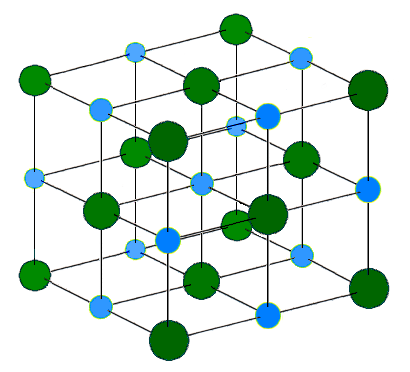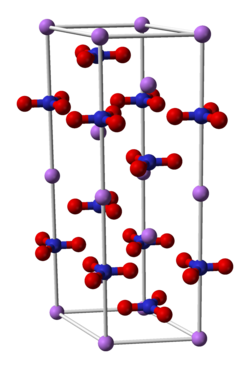General Chemistry/Ionic bonding
What are ions?
Ions are atoms or molecules which are electrically charged. Cations are positively charged and anions carry a negative charge. Ions form when atoms gain or lose electrons. Since electrons are negatively charged, an atom that loses one or more electrons will become positively charged; an atom that gains one or more electrons becomes negatively charged.
Description of Ionic Bonding
Ionic bonding is the attraction between positively- and negatively-charged ions. These oppositely charged ions attract each other to form ionic networks (or lattices). Electrostatics explains why this happens: opposite charges attract and like charges repel. When many ions attract each other, they form large, ordered, crystal lattices in which each ion is surrounded by ions of the opposite charge. Generally, when metals react with non-metals, electrons are transferred from the metals to the non-metals. The metals form positively-charged ions and the non-metals form negatively-charged ions. The smallest unit of an ionic compound is the formula unit, but this unit merely reflects that ratio of ions that leads to neutrality of the whole crystal, e.g. NaCl or MgCl2. One cannot distinguish individual NaCl or MgCl2 molecules in the structure.
It is however possible that the stacking consists of molecular ions like NH4+ and NO3- in ammonium nitrate. In such structures the ions are charged molecules rather than charged atoms.
Characteristics
Example ionic compounds: Sodium chloride (Failed to parse (MathML with SVG or PNG fallback (recommended for modern browsers and accessibility tools): Invalid response ("Math extension cannot connect to Restbase.") from server "https://en.wikipedia.org/api/rest_v1/":): {\displaystyle NaCl} ), potassium nitrate (Failed to parse (MathML with SVG or PNG fallback (recommended for modern browsers and accessibility tools): Invalid response ("Math extension cannot connect to Restbase.") from server "https://en.wikipedia.org/api/rest_v1/":): {\displaystyle KNO_3} ).
Ionically bonded substances typically have the following characteristics.
- High melting point (solid at room temperature)
- Hard but brittle (can shatter)
- Many dissolve in water
- Conductors of electricity when dissolved or melted
In general the forces keeping the lattice together depend on the product of the charges of the ions it consists of. A comparison e.g. of NaCl (+1)*(-1) to MgO (+2)*(-2) shows that magnesium oxide is kept together much more strongly -roughly 4 times- than sodium chloride. This is why sodium chloride has a much lower melting point and also dissolves much more easily in a solvent like water than magnesium oxide does.
Formation
Ionic bonding occurs when metals and non-metals chemically react. As a result of its low ionization energy, a metal atom is not destabilized very much if it loses electrons to form a complete valence shell and becomes positively charged. As its affinity is rather large, a non-metal is stabilized rather strongly by gaining electrons to complete its valence shell and become negatively charged. When metals and non-metals react, the metals lose electrons by transferring them to the non-metals, which gain them. The total process -a small loss plus a large gain- leads to a net lowering of the energy. Consequently, ions are formed, which instantly attract each other leading to ionic bonding.
For instance, in the reaction of Na (sodium) and Cl (chlorine), each Cl atom takes one electron from a Na atom. Therefore each Na becomes a Na+ cation and each Cl atom becomes a Cl- anion. Due to their opposite charges, they attract each other and are joined by millions and millions of other ions to form an ionic lattice. The lattice energy that results from this massive collective stacking further stabilizes the new compound. The formula (ratio of positive to negative ions) in the lattice is NaCl, i.e. there are equal numbers of positive and negative charges ensuring neutrality.
The charges must balance because otherwise the repulsion between the majority charges would become prohibitive. In the case of magnesium chloride, the magnesium atom gives up two electrons to become stable. Note that it is in the second group, so it has two valence electrons. The chlorine atom can only accept one electron, so there must be two chlorine ions for each magnesium ion. Therefore, the formula for magnesium chloride is MgCl2. If magnesium oxide were forming, the formula would be MgO because oxygen can accept both of magnesium's electrons.
- Exercise for the reader
Try figuring out what the formula for magnesium nitride would be. Use the periodic table to help.
It should also be noted that some atoms can form more than one ion. This usually happens with the transition metals. For instance Fe (iron) can become Fe2+ (called iron(II) or -by an older name- ferrous). Fe can also become Fe3+ (called iron(III) or -sometimes still- ferric).
Common Ions
Ionic bonding typically occurs in reactions between a metal and non-metal, but there are also certain molecules called polyatomic ions that undergo ionic bonding. Within these polyatomic ions, there can be covalent (or polar) bonding, but as a unit it undergoes ionic bonding. There are countless polyatomic ions, but you should be familiar with the most common ones. You would be well advised to memorize these ions.
| Name | Formula | Name | Formula |
|---|---|---|---|
| Ammonium | NH4+ | Hydronium | H3O+ |
| Peroxide | O22- | Hydroxide | OH- |
| Nitrite | NO2- | Nitrate | NO3- |
| Sulfite | SO32- | Sulfate | SO42- |
| Hydrogen sulfite | HSO3- | Phosphate | PO43- |
| Hypochlorite | ClO- | Chlorite | ClO2- |
| Chlorate | ClO3- | Perchlorate | ClO4- |
| Carbonate | CO32- | Hydrogen carbonate | HCO3- |


